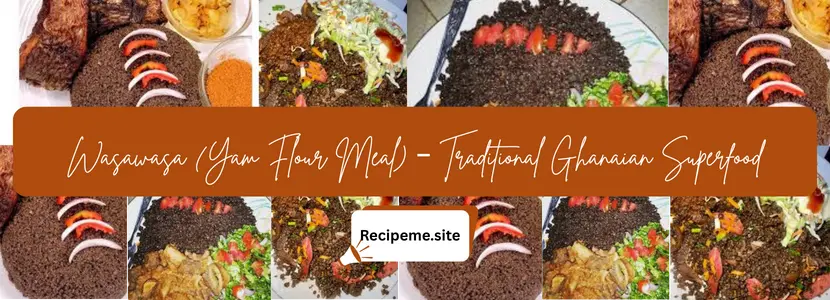
Introduction
Have you ever tasted a dish so earthy and wholesome that it feels like a warm embrace from tradition itself? That’s exactly what Wasawasa, a beloved yam flour meal from Northern Ghana, offers.Served with spicy pepper sauce, beans, or vegetables, Wasawasa is more than just food—it’s a cultural experience. Growing up, many Ghanaians remember waking up to its smoky aroma wafting through the kitchen, often cooked in traditional clay pots over charcoal. It wasn’t just breakfast or dinner; it was comfort, heritage, and nourishment in one plate.
Today, Wasawasa continues to be a staple not only in Ghana but also in parts of Burkina Faso and other West African communities. But what makes this dish so unique? Let’s explore.
History of Wasawasa
Wasawasa traces its roots to the Dagomba people of Northern Ghana, where yam farming has thrived for centuries. Traditionally, leftover yam tubers that could not be preserved were dried, ground into flour, and transformed into Wasawasa—a brilliant way of reducing food waste and ensuring year-round nourishment.
Its preparation method, steaming rather than boiling, preserves nutrients and gives it a distinct smoky flavor. Over time, Wasawasa became a symbol of resilience, ingenuity, and cultural identity for Northern Ghanaians.
Did You Know? Historically, Wasawasa was considered a “poor man’s food” because it was made from leftover yams. Today, however, it is celebrated as a superfood for its health benefits and cultural richness.
Essential Ingredients
The beauty of Wasawasa lies in its simplicity. To prepare this hearty dish, you’ll need:
-
Yam Flour (popularly called “Wakye Powder” in some markets)
-
Water
-
Salt
-
Oil (traditionally shea butter or palm oil for authenticity)
Common Accompaniments:
-
Black-eyed peas or beans
-
Spicy pepper sauce (shito or freshly ground chili sauce)
-
Vegetables (onions, tomatoes, garden eggs)
-
Fried fish, chicken, or eggs
Variations of Wasawasa
Like most traditional African dishes, Wasawasa adapts beautifully to different tastes:
-
Plain Wasawasa: Simply steamed yam flour, served with sauce.
-
Bean-Enriched Wasawasa: Mixed with beans for extra protein.
-
Oil-Rich Wasawasa: Prepared with palm oil or shea butter for a richer taste.
-
Festival Style: Served with fried fish, boiled eggs, and fresh vegetables during celebrations.
Each variation carries its own cultural twist, often reflecting the household or community’s preference.
Preparation: Step-by-Step Guide
Want to try Wasawasa in your own kitchen? Here’s how:
Ingredients for 4 Servings:
-
3 cups yam flour
-
1 teaspoon salt
-
1 cup water (adjust as needed)
-
½ cup palm oil or shea butter
-
Steamed beans (optional)
-
Pepper sauce for serving
Instructions:
-
Moisten the Yam Flour
-
Place yam flour in a bowl. Sprinkle lightly with salted water and rub between your palms until it forms small, moist granules.
-
-
Prepare the Steamer
-
Traditionally, Wasawasa is steamed in a local pot with a perforated plate. At home, you can use a steamer basket.
-
-
Steam the Mixture
-
Transfer the moistened yam flour into the steamer. Steam gently for 30–40 minutes, stirring occasionally to avoid clumps.
-
-
Add Oil
-
When cooked, drizzle palm oil or shea butter over the Wasawasa. Stir to coat evenly.
-
-
Serve Hot
-
Pair with beans, pepper sauce, and vegetables for an authentic experience.
-
Pro Tip: Use shea butter oil for an earthy, traditional flavor that connects you instantly to Northern Ghanaian kitchens.
Cultural Significance
Wasawasa isn’t just food—it’s culture served on a plate.
-
Symbol of Identity: It is a proud dish of the Dagomba people, showcasing the resourcefulness of yam farming communities.
-
Communal Dish: Often shared during festivals, family gatherings, and market days.
-
Rites of Passage: In some regions, Wasawasa is served during naming ceremonies and traditional events.
-
Everyday Staple: A nourishing option for families, especially in rural areas.
Serving Suggestions
Wasawasa is versatile and can be served in many exciting ways:
-
With beans and pepper sauce for a protein-packed meal.
-
With fried fish or chicken for extra richness.
-
With boiled eggs and vegetables for balance.
-
With shito (black pepper sauce) for a spicy kick.
-
As a vegan dish with plant-based oil and veggies.
Did You Know? In Northern Ghana, Wasawasa is sometimes eaten with calabashes (traditional wooden bowls), enhancing the cultural experience.
Types of Yam Flour Meals
Though Wasawasa is the most famous yam flour dish, there are others worth noting:
-
Amala (Nigeria): Made from yam flour but cooked into a stretchy dough.
-
Kokonte (Ghana): Cassava flour meal, similar in preparation style.
-
Wasawasa: Steamed yam flour meal, light and fluffy.
This shows the versatility of yam and cassava flours across West Africa.
Tips for Making the Perfect Wasawasa
-
Always moisten yam flour gradually—too much water makes it soggy.
-
Steam gently on low heat for fluffiness.
-
Stir occasionally during steaming to prevent lumps.
-
Use traditional oils like palm oil or shea butter for authentic taste.
-
Pair with spicy accompaniments for balance.
Other Valuable Information
-
Nutritional Value: Wasawasa is gluten-free, high in carbohydrates, and when paired with beans or fish, offers a complete protein meal.
-
Hidden Fact: Yam flour is rich in resistant starch, which supports gut health.
-
Expert Insight: Nutritionists recommend Wasawasa for energy-giving breakfasts or post-workout meals because of its high fiber and slow-digesting carbs.
Personal Experience: A Journey with Wasawasa
My first encounter with Wasawasa was during a trip to Tamale, Ghana. I remember being invited to a family gathering where the host proudly served steaming bowls of Wasawasa with beans and spicy pepper sauce.
At first bite, the earthy flavor of yam flour combined with the heat of chili awakened my taste buds. But more than the taste, it was the warmth of sharing—a meal eaten together, stories exchanged, laughter shared—that made it unforgettable.
Since then, I’ve tried recreating Wasawasa at home, and while my kitchen lacks the traditional clay pot, every spoonful brings back those beautiful memories of Ghanaian hospitality.
Conclusion
Wasawasa (Yam Flour Meal) is a timeless delicacy that embodies the spirit of Northern Ghana—resourceful, nutritious, and deeply cultural. From its humble beginnings as a “poor man’s food” to its modern recognition as a wholesome superfood, Wasawasa continues to unite families and communities across West Africa.
If you’ve never tried it, perhaps it’s time to bring a little piece of Ghana into your kitchen. After all, food isn’t just about taste—it’s about history, culture, and connection.
Frequently Asked Questions (FAQs)
1. What is Wasawasa made from?
Wasawasa is made from yam flour, steamed and often mixed with palm oil or shea butter, then served with beans, vegetables, or pepper sauce.
2. Is Wasawasa healthy?
Yes, it is gluten-free, rich in complex carbohydrates, and when paired with protein-rich sides like beans or fish, becomes a balanced meal.
3. How does Wasawasa differ from Amala?
Amala (Nigeria) is yam flour cooked into a stretchy dough, while Wasawasa is steamed into a fluffy, couscous-like meal.
4. Can Wasawasa be made without palm oil?
Yes, you can use vegetable oil, shea butter, or even enjoy it plain with sauce and beans.
5. How long does Wasawasa take to cook?
It usually takes 30–40 minutes to steam properly, depending on the quantity and heat level.
6. Can Wasawasa be eaten as a vegan meal?
Absolutely! Wasawasa with plant-based oil, beans, and vegetables is a nourishing vegan-friendly dish.
